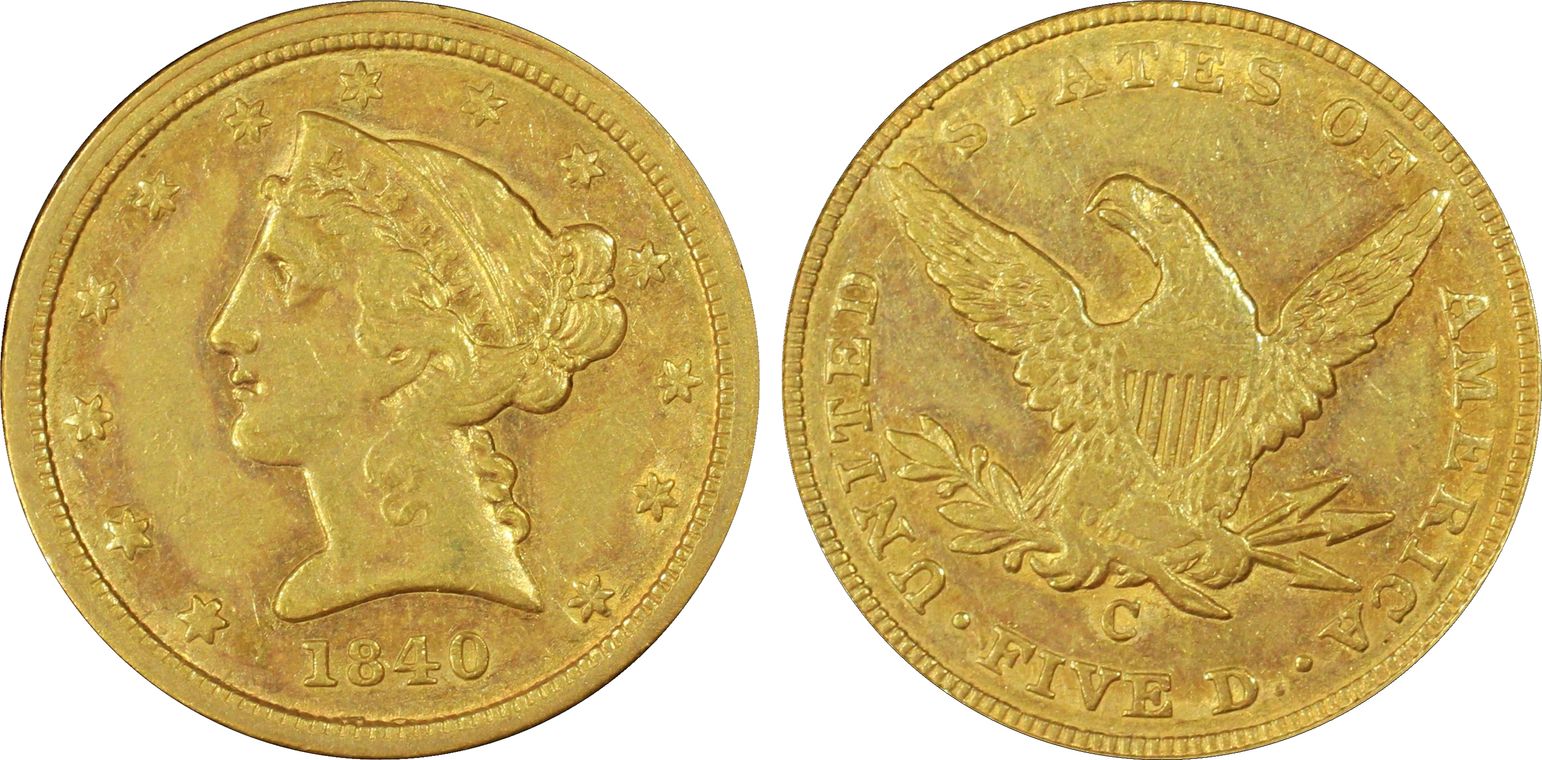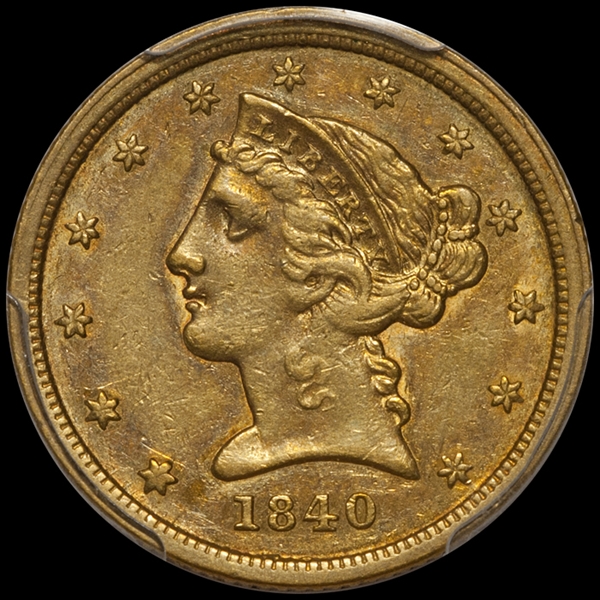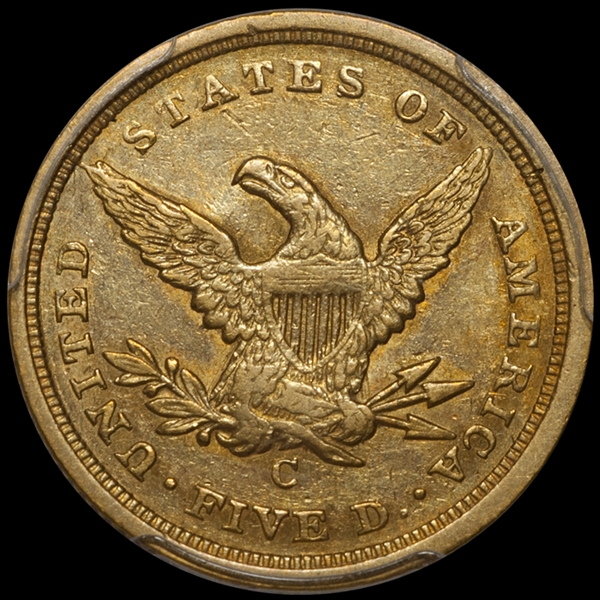1840-C $5 XF45 认证号25242473, PCGS号8196
拥有者评论
CAC
专家评论
Doug Winter
In 1840, the portrait on the half eagle was modified. In addition, the mintmark was moved to the reverse, where it would remain on all half eagles produced at the branch mints until this denomination ceased being minted for circulation in 1929.The 1840-C remains one of the rarest half eagles produced at this mint. It is most often seen in Very Fine or lower grades. A properly graded Extremely Fine example is scarce. It is rare in About Uncirculated with most pieces in this range grading no better than AU50 to AU53. The 1840-C is very rare in AU55 to AU58 and is extremely rare in Uncirculated with just four of five currently accounted for.
STRIKE: The majority of 1840-C half eagles are not well struck. They show weakness on the curls around the face and behind the ear. The top of the head is often weak and the bun is soft. The curl below the ear is weak and it sometimes appears to be broken-off from the base of Liberty’s ear. The stars rarely show any detail while the denticles are weak and poorly defined. The reverse shows an overall softness and the overall appearance suggests that the die might have been lapped to remove clashmarks or rust. The area that shows the most weakness includes the eagle’s right leg, the arrow feathers, both claws and the middle of the neck and shield. The lettering appears somewhat weak and has a slightly “fuzzy” appearance.
SURFACES: The surfaces on nearly every known example show numerous disturbances. These include nicks, cuts, scratches and mint-made areas of roughness. There are a number of 1840-C half eagles that have curious mint-made roughness at the inside of the stars that extends to the border. This affects the eye appeal and such coins typically sell for lower prices than coins struck on well-made planchets.
LUSTER: This date is not often seen with good luster, primarily because most are worn to the point that not much luster survives. On higher grade pieces, the luster is most often frosty in texture. A very small number of semi-prooflike pieces are known as well.
COLORATION: The natural coloration is a deep green-gold hue. A smaller number of pieces are seen with orange-gold or slightly coppery shadings. Very few have original color, as most have been cleaned or dipped. In fact, this is among the rarest of all Charlotte coins with original color and surfaces and any such example is worth a very significant premium over the typical dipped-out 1840-C.
EYE APPEAL: There are not many Charlotte half eagles that are harder to find with good overall eye appeal than the 1840-C. The majority are well worn, poorly struck and heavily abraded. The few attractive pieces that are known have long commanded substantial premiums among knowledgeable specialists.
DIE CHARACTERISTICS: On higher grade examples, there are a number of small die scratches coming up from the denticles at the first star. There is also what appears to be the remnants of a misplaced date punch at the denticles below the 18 in the date. Assuming that this is a misplaced date punch (mpd), it is the only Charlotte coin of any denomination that shows this. Die scratches can be seen at the denticles near many of the stars. These are most predominant at the rim above star seven and below star thirteen.
DIE VARIETIES: Two varieties are known.
Variety 1 (formerly Variety 2-B): The 1 in the date is centered in the field between the bust and the denticles. The 0 is closer to the denticles than to the bust. The reverse uses a medium mintmark and was employed only in 1840. The right edge if the C is over the left edge of the E in FIVE while its left edge is over the V. The mintmark is much closer to the feathers than to the letter V below.
There are at least two die states known:
Die State I: Perfect reverse die.
Die State II: A crack develops from the rim through the I in AMERICA to the tip of the middle arrow head.
Variety 2 (unlisted in past editions of this book): The obverse is the same as Variety 1. The mintmark location is similar to that seen on the other variety but it is slightly further to the left with the serif above (instead of the left of) the upper serif of the E in FIVE. There is usually a bold die crack from the left tip of the feather that runs to the rim.
It appears that the two varieties are of roughly equal rarity.
All 1840-C half eagles seen by me have a large diameter which measures between 22.1 and 22.3 millimeters...I have never seen an 1840-C half eagle with a smaller diameter and do not believe that one exists.
David Akers (1975/88)
This underrated date is very scarce in all grades and is particularly hard to locate better than EF. As a date and in condition it is even more rare than the lower mintage 1839-C. Most specimens are softly struck on the hair curls around Liberty's face but the eagle is invariably sharp. For years, both the broad mill and narrow mill varieties have been reported to exist. However, I have only seen broad mill coins and am therefore dubious of the existence of any specimens with narrow mill.David Hall
In July, 2010 two fresh new coins appeared "out of the woodwork." They are the PCGS graded MS63 and MS64+. The MS64+ is probably the finest known and the the MS63 is probably tied for second finest known with the fantastic John Pittman specimen. These two "new" coins had been basically unknown to the numismatic marketplace and were "discovered" in the Northeast United States were they had been in a family's private holdings for over 50 years.
PCGS #
8196
设计师
Christian Gobrecht
边缘
Reeded
直径
22.50 毫米
重量
8.36 克
铸币数量
18992
金属成分
90% Gold, 10% Copper
更高评级数量
56
评级较低的钱币数量
64
地区
The United States of America
价格指南
PCGS 数量报告
拍卖 - PCGS 评级的
拍卖 - NGC 评级的
稀有性和存量估计 了解更多
| 所有评级 | 500 |
| 60或以上 | 2 |
| 65或以上 | 0 |
| 所有评级 | R-6.0 |
| 60或以上 | R-9.9 |
| 65或以上 | R-10.1 |
| 所有评级 | 96 / 112 TIE |
| 60或以上 | 7 / 112 TIE |
| 65或以上 | 1 / 112 |
| 所有评级 | 136 / 218 TIE |
| 60或以上 | 13 / 218 TIE |
| 65或以上 | 1 / 218 |
























